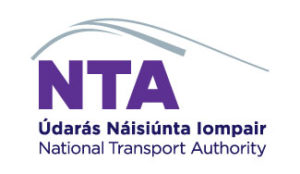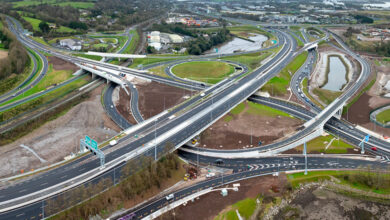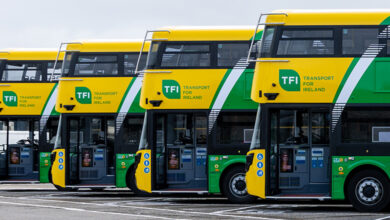NTA making a difference in rural Ireland

Connecting Ireland is the National Transport Authority’s plan to increase public transport connectivity between cities and towns and their surrounding villages and rural areas. Under the proposals, the number of services is set to increase, and so too will overall capacity, making bus transport more useful to more people than ever before. Later this year, NTA will embark on a consultation process around Connecting Ireland, a programme that, as NTA Chief Executive Officer Anne Graham explains, seeks to change the face of public transport in rural Ireland.
When people think of the NTA, they very often think of the work we do around investment in public transport infrastructure and the funding of public transport services in our major urban centres. But there’s more to NTA than BusConnects, MetroLink, Luas and DART. NTA also has a major role in providing public transport for people in regional towns, local villages, and rural areas as part of our Transport for Ireland (TFI) network.
TFI Local Link buses for example, already operate in every county, providing vital connectivity and serving thousands of destinations every day. Operations are funded and supported by the NTA and managed at local level by people who are most familiar with their own communities. In 2019, our Local Link services carried a record 2.5 million passengers.
But there are gaps. Not every person has a bus that can get them to their local village in the morning and back by lunch time. Not every person has a convenient way to get to their closest regional town. Not every person has a useful and frequent connection into the greater national public transport network.
There are gaps, and now we want to go about addressing that. That’s what Connecting Ireland is all about. Connecting Ireland aims to improve mobility in rural areas by improving the existing bus networks, adding new bus services, and enhancing the current Demand Responsive Transport (DRT) network. In so doing, it will also increase passenger journeys throughout the country, creating opportunities for balanced economic growth and stronger regional development.
The current TFI network provides a significant level of spatial coverage outside cities, but nonetheless, over a quarter of the population are either not served at all or only have access to a limited range of public transport services. By addressing and filling these gaps in the public transport network, Connecting Ireland will revitalise rural public transport by better connecting villages, towns, and rural settlements to their nearest city without requiring the use of a car.
Benefits of Connecting Ireland
As part of the Connecting Ireland initiative, the NTA has completed a comprehensive assessment of the existing network of regular public transport services operating across the country on a county-by-county basis. This has given us a clear understanding of how well public transport currently serves our towns and villages in terms of service level at certain times and days of the week. We believe that there is significant potential to further encourage public transport usage in rural communities and that by providing additional services that are more useful to more people, we can tap into that potential.
But Ireland is not densely populated. Outside the major urban centres Ireland’s settlement pattern is distributed in a highly dispersed manner. That makes it difficult to organise public transport services to cater to everyone’s needs in a cost-effective way. In very isolated rural areas, the demand for travel may be so low as to preclude the provision of traditional bus services. These needs may be more readily met by innovative means, such as demand responsive services, local hackney services or community car schemes.
Other factors complicating the delivery of effective public transport in rural Ireland include the trend of an aging population who suffer diminished mobility and the tendency of young people to leave these areas to pursue employment and education in towns and cities. Connecting Ireland gives us an opportunity to examine all of these variables.
The recent success of the NTA’s Rural Transport Programme, TFI Local Link, demonstrates the potential for a more connected rural Ireland. Local Link provides access to essential services, leisure facilities, education, and tourist destinations and under Connecting Ireland we want to significantly expand those benefits through a process of network development.
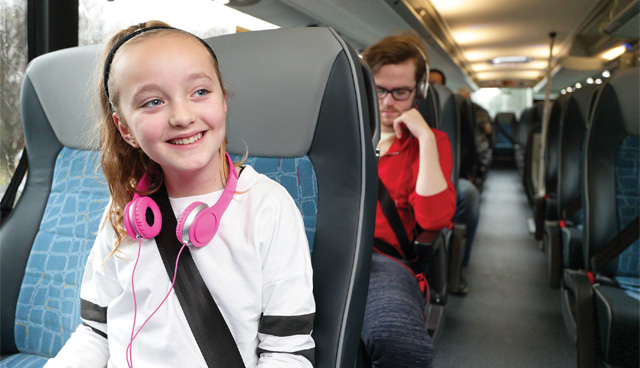
“Connecting Ireland aims to improve mobility in rural areas by improving the existing bus networks, adding new bus services, and enhancing the current Demand Responsive Transport (DRT) network. In so doing, it will also increase passenger journeys throughout the country, creating opportunities for balanced economic growth and stronger regional development.”
As part of our network development process, we will apply the following underlying principles, standards, and objectives:
- Increase frequency on existing routes to attract more passengers;
- Provide a useful minimum level of service on new routes, and do more than that where higher patronage is likely;
- Design useful timetables;
- Schedule services to arrive at a centre before 09:00, particularly for work and education trips;
- Allow for a midday return, particularly for those shopping, attending health appointments, or visiting friends and family;
- Allow for a return from home at around 17:30 and later;
- Provide opportunities for socialising and retail later where potential is higher;
- Provide services seven days a week;
- Develop local routes to connect smaller settlements with the regional public transport network, offering more interchange opportunities with longer distance bus and rail services; and
- Serve key locations within towns e.g. hospitals, train stations, Institutes of Technology, etc.
These principles will help guide improvements to fixed route bus services. In sparsely populated areas fixed routes will not always be an appropriate solution but expansion of the DRT network and looking at innovative approaches to improve public transport connectivity in these areas may well be, if we are to effectively connect outlying areas with their nearest town.
The enhanced network will greatly improve interconnectivity between settlements, and we believe that early Connecting Ireland deliverables could include:
- 50 per cent of the rural population with a service within 400 metres of their home that provides at least three return trips per day;
- 17 per cent of the rural population with improved mobility by the provision of demand responsive and other innovative transport services;
- Over 100 new connections from local centres to rural hinterlands;
- Over 100 new connections to and from county towns; and
- Dozens of new connections from regional centres and cities.
The objectives of Connecting Ireland are derived from the NTA’s Vision to ‘provide quality, accessible, sustainable transport connecting people across Ireland’. From this point of view, the key objectives of the project are:
Economic: To develop a framework for continued delivery and management of a fit-for-purpose all Ireland public transport network outside of the major metropolitan areas.
“The current TFI public transport network coverage outside of the cities is better than it has ever been, but if we are to make public transport more useful for rural communities, more needs to be done.”
Network development: To implement a system of monitoring and evaluation to ensure that the public transport network responds to changes in the factors influencing the demand for transport over time.
Social progress:
- To contribute to a reduction in rural isolation by providing an alternative to the private car for social trips and thereby improve road safety by providing a safe way home;
- To support public policy on developing the night-time economy; and
- To contribute to reducing deprivation across rural Ireland.
Accessibility: To provide improved access to goods, services, employment, and education opportunities for all people in all communities in Ireland at a level appropriate to the size of the community and in line with national planning policy. In particular to:
- Reduce transport deprivation and car dependency;
- Increase the accessibility of more people to more employment and education opportunities and services;
- Provide levels of connectivity appropriate to the scale and function of settlements;
- Provide access to transport services for all users including those with restricted mobility; and
- Provide affordable transport options.
Integration: To improve all elements of integration of the transport network so as to provide more opportunities for interchange and thereby increase the range and variety of destinations accessible within a reasonable journey time.
Regional connectivity: To improve regional connectivity (particularly in areas currently underserved) through enhancements to the public transport network.
Counterbalance: To improve the competitiveness of key towns, regional centres, and cities outside the Greater Dublin Area and to balance economic development and support rural development.
Environmental:
- To encourage the use of sustainable transport options;
- To provide a viable alternative to the private car and thereby encourage a shift to more sustainable transport modes; and
- To reduce the contribution to Climate Change by the transport sector by reducing the use of the private car for mobility.
So, it is clear that Connecting Ireland key component of NTA’s overall plan for public transport and is fully aligned with major national policy programmes and policy frameworks including the National Development Plan, the Climate Action Plan, the Programme for Government and the Rural Development Policy.
Under the National Development Plan, investment in public transport for rural areas is identified as a critical component of strengthening rural economies and communities.
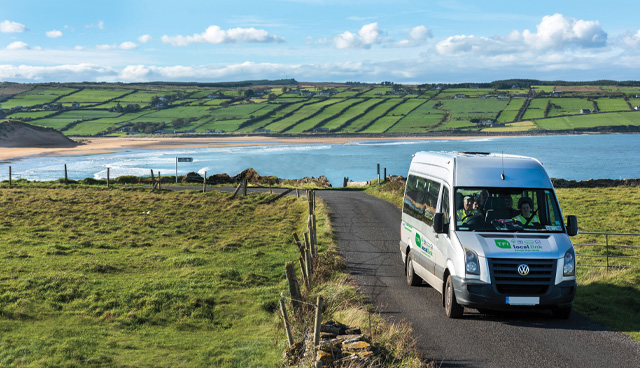
The Climate Action Plan has mandated a new rural transport strategy to include a comprehensive assessment of rural travel demand, and the development of proposals for an integrated public transport network. The transport sector is one of the largest contributors to Ireland’s carbon emissions. Our reliance on the car is the key reason. Seven out of every 10 trips undertaken in Ireland are by car, including half of all trips under 2km. We need to change our habitual travel behaviour, leave the car at home more often, and use sustainable modes.
The Programme for Government 2020 makes a specific commitment for the development and implementation of a sustainable rural mobility plan. This includes the introduction of a public transport service standard under which all settlements over a certain size in terms of population, combined with employment or education places, will have a service connecting them to the national public transport system. This service standard is to be informed by the Connecting Ireland research being carried out by the NTA.
Finally, the Rural Development Policy 2021-2025, published earlier this year, provides for improved rural transport services.
“Connectivity, whether through transport links or digital connectivity, is hugely important for people who live and work in rural areas,” it says. “Improvement and further integration of rural public transport services will enable people to continue to live in rural areas and to access work, education and social activities.”
It goes on to make a commitment to protect and expand regional bus connectivity and connectivity between towns and villages in rural Ireland.
The current TFI public transport network coverage outside of the cities is better than it has ever been, but if we are to make public transport more useful for rural communities, more needs to be done. Two out of five of the population live within 400 metres of a route or service that allows a minimum of at least three return trips every weekday, allowing people to get somewhere by public transport at different times of the day and not just for work and education purposes. However, some 26 per cent of the population are either not served at all or are served by a limited amount of public transport services. This means that for a lot of people, a commute to work or education by public transport is less likely to be an option.
Under Connecting Ireland our ambition is to tackle this by connecting more people to more places. Our analysis has helped us to pinpoint what types of settlement are well connected and where the gaps are. County towns and other local centres are well connected to cities and regional centres. In the future they have an obvious function as transport hubs and to be integrated with routes that serve smaller settlements.
The results for villages are more mixed with four in 10 villages not well connected to their nearby bigger town by public transport. Our analysis also shows that across counties there is some variety in the levels of connectivity. Some of this can be explained by the local geography but in some cases the disparity in service is due to missing elements in the public transport network.
Thanks to Connecting Ireland, we can now begin to identify and address those disparities but revamping an entire transport network is not something that we in the NTA can or should tackle on our own. While the NTA is well positioned to look at the big picture and determine what the overall national approach should be, the insight and expertise that is available to us at local level is something that we want to make sure is fully reflected in our plans.
For the best part of a year, we have been working closely with officials in local authorities, regional assemblies, and other public agencies, so that we can be confident that our analysis of the current and future needs of public transport users in rural areas, properly reflects plans and expectations at a county and regional level. We have provided them with an overview of what our plans will mean nationally, and how we hope they will make a positive impact for them at local level. For their part, they have provided us with very useful insight into their own development ambitions so we can all make sure that plans are working with each other and not against.
Transport providers who are already operating in rural areas are very well placed to provide us with knowledge and awareness as to what passenger current and future needs may be, and this is a resource that as far as NTA is concerned, is hugely valuable as an input into the Connecting Ireland process. This includes our Local Link Transport Co-ordination Units; Public Service Obligation operators such as Bus Éireann; as well as the commercial sector.
Perhaps the most valuable input we will get is that from members of the public and public representatives, and later this year we will be publishing for public consultation the Connecting Ireland plan. In our documentation, we will be outlining the ambitions we have for public transport in rural Ireland, and we will be looking to our customers, members of local communities in rural Ireland as well as representative organisations and interest groups, for their feedback and insight on what we are proposing.
And even if we can’t meet people face to face during this consultation process, we hope to be able to reach out to the public through the likes of online public meetings, surveys, and engagement with public representatives and local media.
Establishing partnerships and opening channels of collaboration and discussion have been key to the early stages of our consultation, and that will continue to be the case.
Once an agreed service plan has been developed following the consultations, the work of the Authority will then move to delivery and subject to the provision of funding our ambition is to commence that delivery in 2022
T: +353 1 879 8300
E: ceo@nationaltransport.ie
W: www.nationaltransport.ie
